萨缪尔森经济学Economics第十八版 18th 课后概念、习题答案7
- 格式:doc
- 大小:72.00 KB
- 文档页数:3
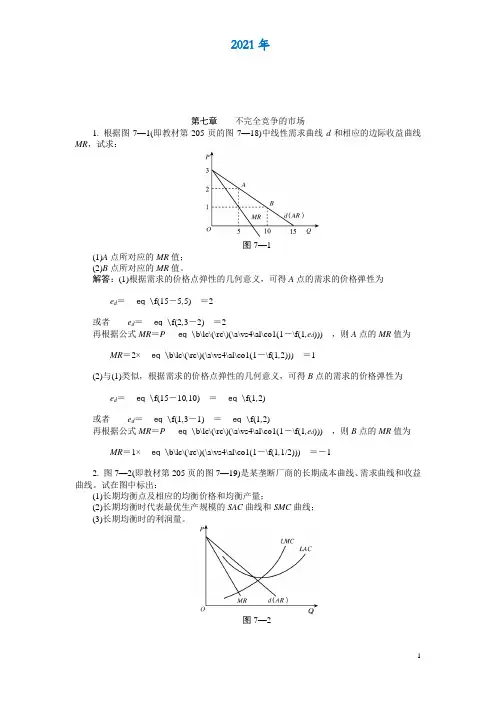
MR,试求:图7—1(1)A点所对应的MR值;(2)B点所对应的MR值。
解答:(1)根据需求的价格点弹性的几何意义,可得A点的需求的价格弹性为e d =eq \f(15-5,5)=2或者e d =eq \f(2,3-2)=2再根据公式MR=P eq \b\lc\(\rc\)(\a\vs4\al\co1(1-\f(1,e d ))),则A点的MR值为MR=2×eq \b\lc\(\rc\)(\a\vs4\al\co1(1-\f(1,2)))=1(2)与(1)类似,根据需求的价格点弹性的几何意义,可得B点的需求的价格弹性为e d =eq \f(15-10,10)=eq \f(1,2)或者e d =eq \f(1,3-1)=eq \f(1,2)再根据公式MR=P eq \b\lc\(\rc\)(\a\vs4\al\co1(1-\f(1,e d ))),则B点的MR值为MR=1×eq \b\lc\(\rc\)(\a\vs4\al\co1(1-\f(1,1/2)))=-12. 图7—2(即教材第205页的图7—19)是某垄断厂商的长期成本曲线、需求曲线和收益曲线。
试在图中标出:(1)长期均衡点及相应的均衡价格和均衡产量;(2)长期均衡时代表最优生产规模的SAC曲线和SMC曲线;(3)长期均衡时的利润量。
图7—2图7—3(1)长期均衡点为E点,因为在E点有MR=LMC。
由E点出发,均衡价格为P0,均衡数量为Q0。
(2)长期均衡时代表最优生产规模的SAC曲线和SMC曲线如图7—3所示。
在Q0的产量上,SAC曲线和LAC曲线相切;SMC曲线和LMC曲线相交,且同时与MR曲线相交。
(3)长期均衡时的利润量由图7—3中阴影部分的面积表示,即π=[AR(Q0)-SAC(Q0)]·Q 0。
3. 已知某垄断厂商的短期总成本函数为STC=0.1Q3-6Q2+140Q+3 000,反需求函数为P=150-3.25Q。
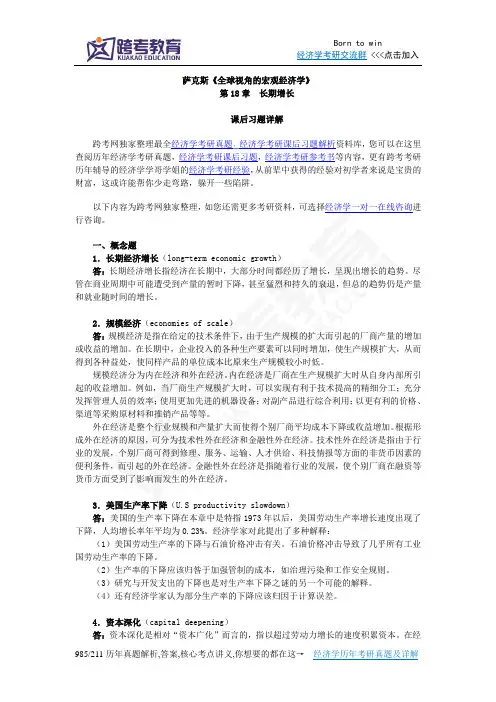
萨克斯《全球视角的宏观经济学》第18章长期增长课后习题详解跨考网独家整理最全经济学考研真题,经济学考研课后习题解析资料库,您可以在这里查阅历年经济学考研真题,经济学考研课后习题,经济学考研参考书等内容,更有跨考考研历年辅导的经济学学哥学姐的经济学考研经验,从前辈中获得的经验对初学者来说是宝贵的财富,这或许能帮你少走弯路,躲开一些陷阱。
以下内容为跨考网独家整理,如您还需更多考研资料,可选择经济学一对一在线咨询进行咨询。
一、概念题1.长期经济增长(long-term economic growth)答:长期经济增长指经济在长期中,大部分时间都经历了增长,呈现出增长的趋势。
尽管在商业周期中可能遭受到产量的暂时下降,甚至猛烈和持久的衰退,但总的趋势仍是产量和就业随时间的增长。
2.规模经济(economies of scale)答:规模经济是指在给定的技术条件下,由于生产规模的扩大而引起的厂商产量的增加或收益的增加。
在长期中,企业投入的各种生产要素可以同时增加,使生产规模扩大,从而得到各种益处,使同样产品的单位成本比原来生产规模较小时低。
规模经济分为内在经济和外在经济。
内在经济是厂商在生产规模扩大时从自身内部所引起的收益增加。
例如,当厂商生产规模扩大时,可以实现有利于技术提高的精细分工;充分发挥管理人员的效率;使用更加先进的机器设备;对副产品进行综合利用;以更有利的价格、渠道等采购原材料和推销产品等等。
外在经济是整个行业规模和产量扩大而使得个别厂商平均成本下降或收益增加。
根据形成外在经济的原因,可分为技术性外在经济和金融性外在经济。
技术性外在经济是指由于行业的发展,个别厂商可得到修理、服务、运输、人才供给、科技情报等方面的非货币因素的便利条件,而引起的外在经济。
金融性外在经济是指随着行业的发展,使个别厂商在融资等货币方面受到了影响而发生的外在经济。
3.美国生产率下降(U.S productivity slowdown)答:美国的生产率下降在本章中是特指1973年以后,美国劳动生产率增长速度出现了下降,人均增长率年平均为0.23%。
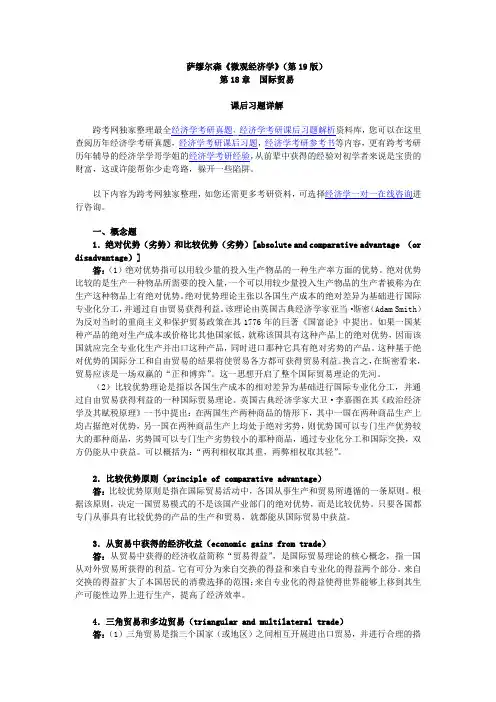
萨缪尔森《微观经济学》(第19版)第18章国际贸易课后习题详解跨考网独家整理最全经济学考研真题,经济学考研课后习题解析资料库,您可以在这里查阅历年经济学考研真题,经济学考研课后习题,经济学考研参考书等内容,更有跨考考研历年辅导的经济学学哥学姐的经济学考研经验,从前辈中获得的经验对初学者来说是宝贵的财富,这或许能帮你少走弯路,躲开一些陷阱。
以下内容为跨考网独家整理,如您还需更多考研资料,可选择经济学一对一在线咨询进行咨询。
一、概念题1.绝对优势(劣势)和比较优势(劣势)[absolute and comparative advantage (or disadvantage)]答:(1)绝对优势指可以用较少量的投入生产物品的一种生产率方面的优势。
绝对优势比较的是生产一种物品所需要的投入量,一个可以用较少量投入生产物品的生产者被称为在生产这种物品上有绝对优势。
绝对优势理论主张以各国生产成本的绝对差异为基础进行国际专业化分工,并通过自由贸易获得利益。
该理论由英国古典经济学家亚当·斯密(Adam Smith)为反对当时的重商主义和保护贸易政策在其1776年的巨著《国富论》中提出。
如果一国某种产品的绝对生产成本或价格比其他国家低,就称该国具有这种产品上的绝对优势,因而该国就应完全专业化生产并出口这种产品,同时进口那种它具有绝对劣势的产品。
这种基于绝对优势的国际分工和自由贸易的结果将使贸易各方都可获得贸易利益。
换言之,在斯密看来,贸易应该是一场双赢的“正和博弈”。
这一思想开启了整个国际贸易理论的先河。
(2)比较优势理论是指以各国生产成本的相对差异为基础进行国际专业化分工,并通过自由贸易获得利益的一种国际贸易理论。
英国古典经济学家大卫·李嘉图在其《政治经济学及其赋税原理》一书中提出:在两国生产两种商品的情形下,其中一国在两种商品生产上均占据绝对优势,另一国在两种商品生产上均处于绝对劣势,则优势国可以专门生产优势较大的那种商品,劣势国可以专门生产劣势较小的那种商品,通过专业化分工和国际交换,双方仍能从中获益。
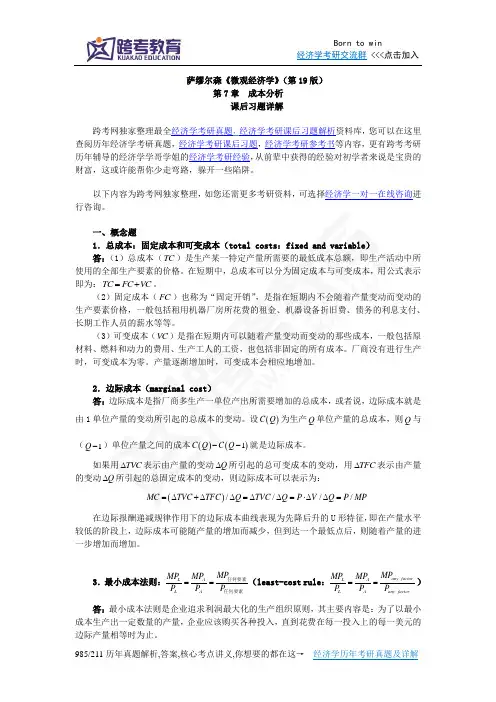
萨缪尔森《微观经济学》(第19版)第7章 成本分析课后习题详解跨考网独家整理最全经济学考研真题,经济学考研课后习题解析资料库,您可以在这里查阅历年经济学考研真题,经济学考研课后习题,经济学考研参考书等内容,更有跨考考研历年辅导的经济学学哥学姐的经济学考研经验,从前辈中获得的经验对初学者来说是宝贵的财富,这或许能帮你少走弯路,躲开一些陷阱。
以下内容为跨考网独家整理,如您还需更多考研资料,可选择经济学一对一在线咨询进行咨询。
一、概念题1.总成本:固定成本和可变成本(total costs :fixed and variable ) 答:(1)总成本(TC )是生产某一特定产量所需要的最低成本总额,即生产活动中所使用的全部生产要素的价格。
在短期中,总成本可以分为固定成本与可变成本,用公式表示即为:TC FC VC =+。
(2)固定成本(FC )也称为“固定开销”,是指在短期内不会随着产量变动而变动的生产要素价格,一般包括租用机器厂房所花费的租金、机器设备折旧费、债务的利息支付、长期工作人员的薪水等等。
(3)可变成本(VC )是指在短期内可以随着产量变动而变动的那些成本,一般包括原材料、燃料和动力的费用、生产工人的工资,也包括非固定的所有成本。
厂商没有进行生产时,可变成本为零。
产量逐渐增加时,可变成本会相应地增加。
2.边际成本(marginal cost )答:边际成本是指厂商多生产一单位产出所需要增加的总成本,或者说,边际成本就是由1单位产量的变动所引起的总成本的变动。
设()C Q 为生产Q 单位产量的总成本,则Q 与(1Q -)单位产量之间的成本()()1C Q C Q --就是边际成本。
如果用TVC ∆表示由产量的变动Q ∆所引起的总可变成本的变动,用TFC ∆表示由产量的变动Q ∆所引起的总固定成本的变动,则边际成本可以表示为:()////MC TVC TFC Q TVC Q P V Q P MP =∆+∆∆=∆∆=⋅∆∆=在边际报酬递减规律作用下的边际成本曲线表现为先降后升的U 形特征,即在产量水平较低的阶段上,边际成本可能随产量的增加而减少,但到达一个最低点后,则随着产量的进一步增加而增加。
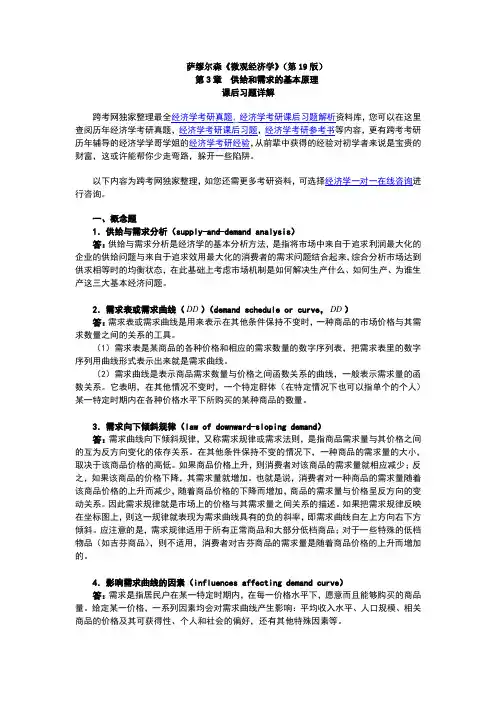
萨缪尔森《微观经济学》(第19版)第3章供给和需求的基本原理课后习题详解跨考网独家整理最全经济学考研真题,经济学考研课后习题解析资料库,您可以在这里查阅历年经济学考研真题,经济学考研课后习题,经济学考研参考书等内容,更有跨考考研历年辅导的经济学学哥学姐的经济学考研经验,从前辈中获得的经验对初学者来说是宝贵的财富,这或许能帮你少走弯路,躲开一些陷阱。
以下内容为跨考网独家整理,如您还需更多考研资料,可选择经济学一对一在线咨询进行咨询。
一、概念题1.供给与需求分析(supply-and-demand analysis)答:供给与需求分析是经济学的基本分析方法,是指将市场中来自于追求利润最大化的企业的供给问题与来自于追求效用最大化的消费者的需求问题结合起来,综合分析市场达到供求相等时的均衡状态,在此基础上考虑市场机制是如何解决生产什么、如何生产、为谁生产这三大基本经济问题。
2.需求表或需求曲线(DD)(demand schedule or curve,DD)答:需求表或需求曲线是用来表示在其他条件保持不变时,一种商品的市场价格与其需求数量之间的关系的工具。
(1)需求表是某商品的各种价格和相应的需求数量的数字序列表,把需求表里的数字序列用曲线形式表示出来就是需求曲线。
(2)需求曲线是表示商品需求数量与价格之间函数关系的曲线,一般表示需求量的函数关系。
它表明,在其他情况不变时,一个特定群体(在特定情况下也可以指单个的个人)某一特定时期内在各种价格水平下所购买的某种商品的数量。
3.需求向下倾斜规律(law of downward-sloping demand)答:需求曲线向下倾斜规律,又称需求规律或需求法则,是指商品需求量与其价格之间的互为反方向变化的依存关系。
在其他条件保持不变的情况下,一种商品的需求量的大小,取决于该商品价格的高低。
如果商品价格上升,则消费者对该商品的需求量就相应减少;反之,如果该商品的价格下降,其需求量就增加。
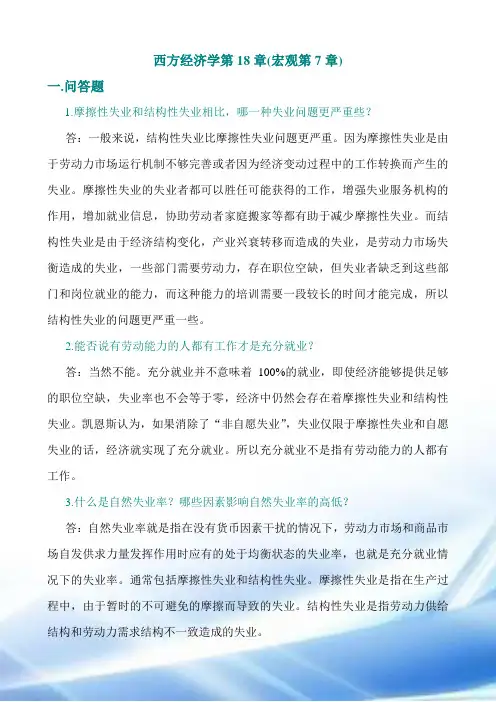
西方经济学第18章(宏观第7章)一.问答题1.摩擦性失业和结构性失业相比,哪一种失业问题更严重些?答:一般来说,结构性失业比摩擦性失业问题更严重。
因为摩擦性失业是由于劳动力市场运行机制不够完善或者因为经济变动过程中的工作转换而产生的失业。
摩擦性失业的失业者都可以胜任可能获得的工作,增强失业服务机构的作用,增加就业信息,协助劳动者家庭搬家等都有助于减少摩擦性失业。
而结构性失业是由于经济结构变化,产业兴衰转移而造成的失业,是劳动力市场失衡造成的失业,一些部门需要劳动力,存在职位空缺,但失业者缺乏到这些部门和岗位就业的能力,而这种能力的培训需要一段较长的时间才能完成,所以结构性失业的问题更严重一些。
2.能否说有劳动能力的人都有工作才是充分就业?答:当然不能。
充分就业并不意味着100%的就业,即使经济能够提供足够的职位空缺,失业率也不会等于零,经济中仍然会存在着摩擦性失业和结构性失业。
凯恩斯认为,如果消除了“非自愿失业”,失业仅限于摩擦性失业和自愿失业的话,经济就实现了充分就业。
所以充分就业不是指有劳动能力的人都有工作。
3.什么是自然失业率?哪些因素影响自然失业率的高低?答:自然失业率就是指在没有货币因素干扰的情况下,劳动力市场和商品市场自发供求力量发挥作用时应有的处于均衡状态的失业率,也就是充分就业情况下的失业率。
通常包括摩擦性失业和结构性失业。
摩擦性失业是指在生产过程中,由于暂时的不可避免的摩擦而导致的失业。
结构性失业是指劳动力供给结构和劳动力需求结构不一致造成的失业。
生产力的发展、技术进步以及制度因素是决定自然失业率及引起自然失业率提高的重要因素。
具体包括:(1)劳动者结构的变化。
一般来说,青年和妇女的自然失业率高,而这些人在劳动力总数中所占比例的上升会导致自然失业率上升。
(2)政府政策的影响。
如失业救济制度使一些人宁可失业也不从事工资低、条件差的职业,这就增加了自然失业中的“寻业的失业”;最低工资法使企业尽量少雇佣人,尤其是技术水平差的工人,同时也加强了用机器取代工人的趋势。
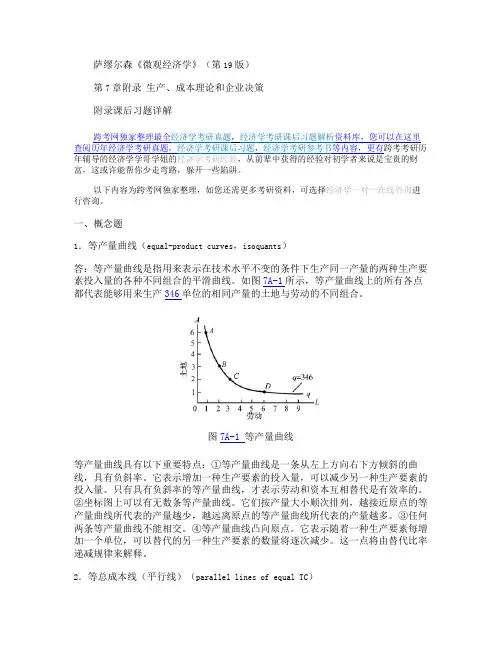
萨缪尔森《微观经济学》(第19版)第7章附录生产、成本理论和企业决策附录课后习题详解跨考网独家整理最全经济学考研真题,经济学考研课后习题解析资料库,您可以在这里查阅历年经济学考研真题,经济学考研课后习题,经济学考研参考书等内容,更有跨考考研历年辅导的经济学学哥学姐的经济学考研经验,从前辈中获得的经验对初学者来说是宝贵的财富,这或许能帮你少走弯路,躲开一些陷阱。
以下内容为跨考网独家整理,如您还需更多考研资料,可选择经济学一对一在线咨询进行咨询。
一、概念题1.等产量曲线(equal-product curves,isoquants)答:等产量曲线是指用来表示在技术水平不变的条件下生产同一产量的两种生产要素投入量的各种不同组合的平滑曲线。
如图7A-1所示,等产量曲线上的所有各点都代表能够用来生产346单位的相同产量的土地与劳动的不同组合。
图7A-1 等产量曲线等产量曲线具有以下重要特点:①等产量曲线是一条从左上方向右下方倾斜的曲线,具有负斜率。
它表示增加一种生产要素的投入量,可以减少另一种生产要素的投入量。
只有具有负斜率的等产量曲线,才表示劳动和资本互相替代是有效率的。
②坐标图上可以有无数条等产量曲线。
它们按产量大小顺次排列,越接近原点的等产量曲线所代表的产量越少,越远离原点的等产量曲线所代表的产量越多。
③任何两条等产量曲线不能相交。
④等产量曲线凸向原点。
它表示随着一种生产要素每增加一个单位,可以替代的另一种生产要素的数量将逐次减少。
这一点将由替代比率递减规律来解释。
2.等总成本线(平行线)(parallel lines of equal TC)等总成本线简称等成本线,是指在某一给定的时期,在现行市场价格上,企业花费同样的总成本所能够购买的两种要素使用量的所有可能的组合。
在既定的一条等成本线上的各点代表相同的总成本。
一般地,总成本()由以下等成本线方程决定:,根据上式,在成本和生产要素价格既定条件下,增加劳动购买量就会减少资本品的购买量,可购买的劳动和资本品的数量组合位于由所决定的一条以横轴为劳动()和纵轴为资本()的等成本线上。
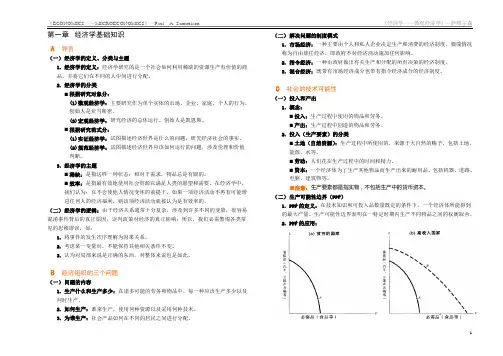
第一章经济学基础知识A 导言(一)经济学的定义、分类与主题1.经济学的定义:经济学研究的是一个社会如何利用稀缺的资源生产有价值的商品,并将它们在不同的人中间进行分配。
2.经济学的分类⏹根据研究对象分:(1)微观经济学:主要研究作为单个实体的市场、企业、家庭、个人的行为。
创始人是亚当斯密。
(2)宏观经济学:研究经济的总体运行。
创始人是凯恩斯。
⏹根据研究范式分:(1)实证经济学:试图描述经济世界是什么的问题,研究经济社会的事实。
(2)规范经济学:试图描述经济世界应该如何运行的问题,涉及伦理和价值判断。
3.经济学的主题⏹稀缺:是指这样一种状态:相对于需求,物品总是有限的。
⏹效率:是指最有效地使用社会资源以满足人类的愿望和需要。
在经济学中,我们认为:在不会使他人情况变坏的前提下,如果一项经济活动不再有可能增进任何人的经济福利,则该项经济活动就被认为是有效率的。
(二)经济学的逻辑:由于经济关系通常十分复杂,涉及到许多不同的变量,很容易混淆事件背后的真正原因,误判政策对经济的真正影响;所以,我们必需警惕各类常见的思维谬误,如:1.将事件的发生次序理解为因果关系。
2.考虑某一变量时,不能保持其他相关条件不变。
3.认为对局部来说是正确的东西,对整体来说也是如此。
B 经济组织的三个问题(一)问题的内容1.生产什么和生产多少:在诸多可能的劳务和物品中,每一种应该生产多少以及何时生产。
2.如何生产:谁来生产,使用何种资源以及采用何种技术。
3.为谁生产:社会产品如何在不同的居民之间进行分配。
(二)解决问题的制度模式1.市场经济:一种主要由个人和私人企业决定生产和消费的经济制度。
极端情况称为自由放任经济,即政府不对经济活动施加任何影响。
2.指令经济:一种由政府做出有关生产和分配的所有决策的经济制度。
3.混合经济:既带有市场经济成分也带有指令经济成分的经济制度。
C 社会的技术可能性(一)投入和产出1.概念:⏹投入:生产过程中使用的物品和劳务。
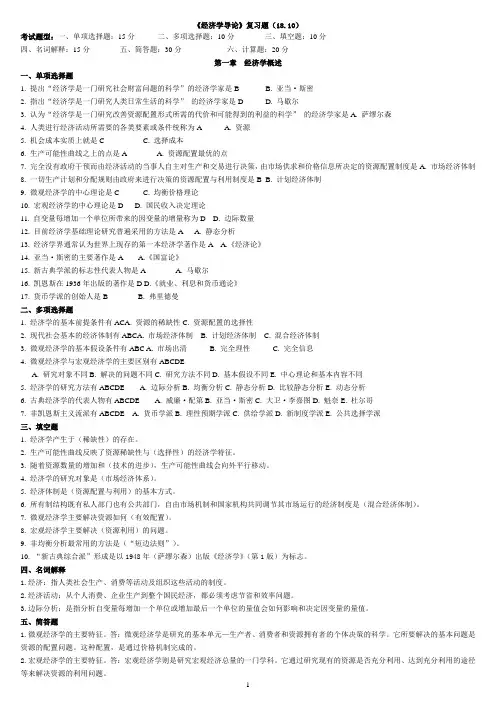
《经济学导论》复习题(18.10)考试题型:一、单项选择题:15分二、多项选择题:10分三、填空题:10分四、名词解释:15分五、简答题:30分六、计算题:20分第一章经济学概述一、单项选择题1. 提出“经济学是一门研究社会财富问题的科学”的经济学家是B B. 亚当·斯密2. 指出“经济学是一门研究人类日常生活的科学” 的经济学家是D D. 马歇尔3. 认为“经济学是一门研究改善资源配置形式所需的代价和可能得到的利益的科学”的经济学家是A. 萨缪尔森4. 人类进行经济活动所需要的各类要素或条件统称为A A. 资源5. 机会成本实质上就是C C. 选择成本6. 生产可能性曲线之上的点是A A. 资源配置最优的点7. 完全没有政府干预而由经济活动的当事人自主对生产和交易进行决策,由市场供求和价格信息所决定的资源配置制度是A. 市场经济体制8. 一切生产计划和分配规则由政府来进行决策的资源配置与利用制度是B B. 计划经济体制9. 微观经济学的中心理论是C C. 均衡价格理论10. 宏观经济学的中心理论是D D. 国民收入决定理论11. 自变量每增加一个单位所带来的因变量的增量称为D D. 边际数量12. 目前经济学基础理论研究普遍采用的方法是A A. 静态分析13. 经济学界通常认为世界上现存的第一本经济学著作是A A.《经济论》14. 亚当·斯密的主要著作是A A.《国富论》15. 新古典学派的标志性代表人物是A A. 马歇尔16. 凯恩斯在1936年出版的著作是D D.《就业、利息和货币通论》17. 货币学派的创始人是B B. 弗里德曼二、多项选择题1. 经济学的基本前提条件有ACA. 资源的稀缺性C. 资源配置的选择性2. 现代社会基本的经济体制有ABCA. 市场经济体制 B. 计划经济体制 C. 混合经济体制3. 微观经济学的基本假设条件有ABC A. 市场出清 B. 完全理性 C. 完全信息4. 微观经济学与宏观经济学的主要区别有ABCDEA. 研究对象不同B. 解决的问题不同C. 研究方法不同D. 基本假设不同E. 中心理论和基本内容不同5. 经济学的研究方法有ABCDE A. 边际分析B. 均衡分析C. 静态分析D. 比较静态分析E. 动态分析6. 古典经济学的代表人物有ABCDE A. 威廉·配第B.亚当·斯密C.大卫·李嘉图D. 魁奈E. 杜尔哥7. 非凯恩斯主义流派有ABCDE A. 货币学派B. 理性预期学派C. 供给学派D. 新制度学派E. 公共选择学派三、填空题1. 经济学产生于(稀缺性)的存在。
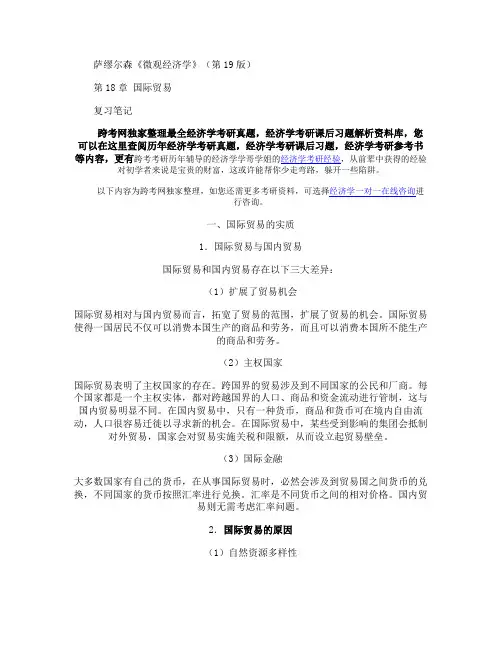
萨缪尔森《微观经济学》(第19版)第18章国际贸易复习笔记跨考网独家整理最全经济学考研真题,经济学考研课后习题解析资料库,您可以在这里查阅历年经济学考研真题,经济学考研课后习题,经济学考研参考书等内容,更有跨考考研历年辅导的经济学学哥学姐的经济学考研经验,从前辈中获得的经验对初学者来说是宝贵的财富,这或许能帮你少走弯路,躲开一些陷阱。
以下内容为跨考网独家整理,如您还需更多考研资料,可选择经济学一对一在线咨询进行咨询。
一、国际贸易的实质1.国际贸易与国内贸易国际贸易和国内贸易存在以下三大差异:(1)扩展了贸易机会国际贸易相对与国内贸易而言,拓宽了贸易的范围,扩展了贸易的机会。
国际贸易使得一国居民不仅可以消费本国生产的商品和劳务,而且可以消费本国所不能生产的商品和劳务。
(2)主权国家国际贸易表明了主权国家的存在。
跨国界的贸易涉及到不同国家的公民和厂商。
每个国家都是一个主权实体,都对跨越国界的人口、商品和资金流动进行管制,这与国内贸易明显不同。
在国内贸易中,只有一种货币,商品和货币可在境内自由流动,人口很容易迁徙以寻求新的机会。
在国际贸易中,某些受到影响的集团会抵制对外贸易,国家会对贸易实施关税和限额,从而设立起贸易壁垒。
(3)国际金融大多数国家有自己的货币,在从事国际贸易时,必然会涉及到贸易国之间货币的兑换,不同国家的货币按照汇率进行兑换。
汇率是不同货币之间的相对价格。
国内贸易则无需考虑汇率问题。
2.国际贸易的原因(1)自然资源多样性由于各国生产条件的差异,国家之间存在着进行贸易的可能性。
在一定程度上,这些生产条件的差异反映了自然资源禀赋情况方面的差异。
(2)偏好不同即使所有国家和地区的生产条件是相同的,但如果它们对商品的偏好不同,则国与国之间也还是需要进行贸易。
某些国家居民所偏好的商品在国内无法生产,但是通过国际贸易,该国居民可以获得其所偏好的商品,从而获得满足。
(3)成本差异进行贸易的最重要的原因可能是各国在生产成本上存在差异。
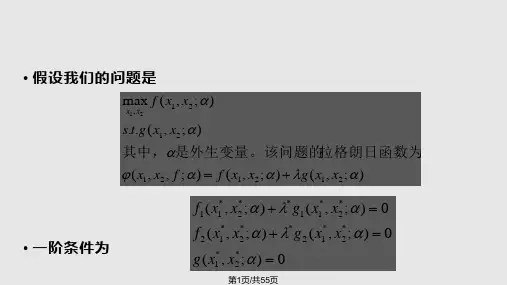
萨缪尔森《宏观经济学》(第19版)第7章商业周期和总需求理论课后习题详解跨考网独家整理最全经济学考研真题,经济学考研课后习题解析资料库,您可以在这里查阅历年经济学考研真题,经济学考研课后习题,经济学考研参考书等内容,更有跨考考研历年辅导的经济学学哥学姐的经济学考研经验,从前辈中获得的经验对初学者来说是宝贵的财富,这或许能帮你少走弯路,躲开一些陷阱。
以下内容为跨考网独家整理,如您还需更多考研资料,可选择经济学一对一在线咨询进行咨询。
一、概念题1.商业周期(business cycle)答:商业周期是以产业经济为主的国家总体经济活动的一种有一定规律的波动,持续时间通常为2至10年,以大多数经济活动的同时扩张或者收缩为标志,以产量、价格、投资、商业利润和各种货币变量等重要宏观经济变量趋于有规则的一起变动为重要特征。
一个完整的经济周期包括繁荣、衰退、萧条、复苏(也可以称为扩张、衰退、收缩、复苏)四个阶段。
在繁荣阶段,经济活动全面扩张,不断达到新的高峰。
在衰退阶段,经济短时间保持均衡后出现紧缩的趋势。
在萧条阶段,经济出现急剧的收缩和下降,很快从活动量的最高点下降到最低点。
在复苏阶段,经济从最低点恢复并逐渐上升到先前的活动量高度,进入繁荣。
衡量经济周期处于什么阶段,主要依据国民生产总值、工业生产指数、就业和收入、价格指数、利息率等综合经济活动指标的波动。
在一个经济周期中,“波峰”与“波谷”一般代表周期的转折点。
每一次周期都是从低谷或经济活动的一个低水平开始,随后扩张阶段开始,最后经济达到波峰即周期的最高点,随后又进入收缩期,一段时间以后,经济跌入另一次低谷,此后开始又一个扩张时期,其变动方式如图7-7所示。
图7-7 商业周期形式商业周期重复发生,但持续时间并不固定。
尽管不同国家在不同时期,周期并不一样,但它们具有若干重要的一般的特征,所以可以对它们进行系统的研究。
商业周期的类型按照其频率、幅度、持续时间的不同,可以划分为短周期、中周期、长周期三类。
第十八章失业与通货膨胀1. 摩擦性失业与结构性失业相比,哪一种失业问题更严重些?解答:一般来说,结构性失业比摩擦性失业问题更严重。
因为摩擦性失业是由于劳动力市场运行机制不完善或者经济变动过程中的工作转换而产生的失业。
摩擦性失业的失业者都可以胜任可能获得的工作,所以增强失业效劳机构的作用,增加就业信息,协助劳动者家庭搬家等都有助于减少摩擦性失业。
而结构性失业是由经济结构变化、产业兴衰转移而造成的失业,是劳动力市场失衡造成的失业,一些部门需要劳动力,存在职位空缺,但失业者缺乏到这些部门和岗位就业的能力,而这种能力的培训需要一段较长的时间才能完成,所以结构性失业的问题更严重一些。
2. 能否说有劳动能力的人都有工作才是充分就业?解答:不能。
充分就业并不意味着100%的就业,即使经济能够提供足够的职位空缺,失业率也不会等于零,经济中仍然会存在着摩擦性失业和结构性失业。
凯恩斯认为,如果消除了“非自愿失业〞,失业仅限于摩擦性失业和自愿失业的话,经济就实现了充分就业。
所以充分就业不是指有劳动能力的人都有工作。
3. 什么是自然失业率?哪些因素影响自然失业率的上下?解答:自然失业率就是指在没有货币因素干扰的情况下,劳动力市场和商品市场自发供求力量发挥作用时应有的处于均衡状态的失业率,也就是充分就业情况下的失业率。
通常包括摩擦性失业和结构性失业。
生产力的开展、技术进步以及制度因素是决定自然失业率及引起自然失业率提高的重要因素。
具体包括:(1)劳动者结构的变化。
一般来说,青年与妇女的自然失业率高,这些人在劳动力总数中所占比例的上升会导致自然失业率上升。
(2)政府政策的影响。
如失业救济制度使一些人宁可失业也不从事工资低、条件差的职业,这就增加了自然失业中的“寻业的失业〞;最低工资法使企业尽量少雇用人,尤其是技术水平差的工人,同时也加强了用机器取代工人的趋势。
(3)技术进步因素。
随着新技术、新设备的投入使用,劳动生产率不断提高,资本的技术构成不断提高,必然要减少对劳动力的需求,出现较多失业;同时,技术进步使一些文化技术水平低的工人不能适应新的工作而被淘汰。
学习指南勘误:
1.p85页第7章第16题:答案“c"改…b"
2.p104页第8章第21题:答案”c"改“d”
3.p122页第9章第24题:答案“c”改“d”
4.p130页第10章第5题和第7题选项a中“承担得起”改为“承担不起”。
5.p132页第10章第24题:答案“b”改“d”
6.p142页第18题:答案“e”改“b”;第20题:答案“d”改“e”
7.p153页第12章第5题:选项c“为谁分配”建议改为“为谁生产”更妥
8. p154页第12章第10题:答案“a”改“c”;p155页第18题:提干中原“第15题所给定信息”改为“第16题所给定信息”,原“在此假设基础上,第16题中哪一项是正确的?”改为“在此假设基础上,第17题中哪一项是正确的?”:另外答案“c”改“b”。
此外,p38页第3章解答题部分第5题表3-5中需求量和供给量数据互换。
P71页第5题图5A-9图不完整,不能做此题。
西经教研室
2012年11月24日。
C H A P T E R 7A n a l y s i so f C o s t sCHAPTER OVERVIEW AND TEACHING TIPSThis chapter brings into focus the wide range of cost measures used by economists: total cost, fixed cost, variable cost, average total cost, average fixed cost, average variable cost, and marginal cost.Minimum production costs for a firm are represented along a total cost schedule, which is a function of the level of output. Inputs used in their least-cost combination link the production function with the cost curves, and it is the ability to adjust the employment of inputs that provides the distinction between the two components of short-run total cost: variable cost and fixed cost. The major objective here is for students to obtain a solid understanding of an economist’s perspective of cost accounting, so that subsequent descriptions of market structure will make sense. The student is expected to use tables and diagrams to develop an understanding of both specific examples and more general representa- tions of cost concepts.Chapter 7 also provides a brief introduction to accounting practices. The introduction here is short, covering only two basic tools—the balance sheet and the income statement. The balance sheet is a snapshot of financial health; it reflects the economic condition of an economic entity at some prescribed point in time. The income statement, by wayof contrast, is a motion picture, reflecting growth over a given period of time; it describes the path a firm takes between two different balance sheets.LEARNING OBJECTIVES1. Define and describe total cost, fixed cost, variable cost, marginal cost, and average cost, explainingwhat these measures of cost are designed to reflect and how they are related to one another.2. Derive the associated average and marginal cost statistics from total, fixed, and variable cost.3. Explain the link between productivity and cost.4. Demonstrate precisely why marginal cost always intersects average cost at the minimum of any U-shaped averagecost curve.5. Demonstrate why production costs are minimized when inputs are hired in combinations such that the ratios of theirmarginal products to their prices are all equal.6. Explain carefully the information that a balance sheet is intended to convey. List the major categories appearing onthe two sides of a balance sheet, and indicate the meaning (or definition) of each of those categories.7. List the major items appearing on an income statement. Indicate the information that an incomestatement is intended to convey.8. Explain the role of depreciation and opportunity cost in the correct and accurate construction ofan income statement.9. Define the term opportunity cost and apply it to management decisions made by firms and individuals SUGGESTED ANSWERS TO QUESTIONS IN THE TEXT1. a. .344b. At the end of 1959 his average was .346. His average for 1960 was .316. Since his average in 1960 was belowhis lifetime average the 1960 average pulled his lifetime average down.2. MC and AVC do not change; TC, AC, and AFC shift up. Minimum occurs where MC = AC = $60 at 5 units.2930 C HAPTER 7: A NALYSIS OF C OSTS 3. AC above (below) MC means that the next increment lowers (increases) the average; i.e., AC is falling (climbing).Only when MC = AC is AC neither rising nor falling; i.e., it is at its minimum.4. With a volunteer army the government must be concerned about attracting soldiers. People will agree to enlistonly when the wages they are paid cover their opportunity costs. If service is compulsory, the government has no such constraints on its wage scheme.5. a. Fixed cost equals 15 $12 = $180. MC is the cost of the labor required for each unit increase in output: $30,$25, $20, $30, $50, $70, $90. Variable cost is total labor times the wage: $30, $55, $65, $l05, $l55, $225, $315.b.Doubling the wage increases AC and MC (doubles, in fact, MC but not AC).c.Doubling productivity cuts MC and AC in half. (Factor prices and productivity both influence cost curves.)6. a.Average costs are minimized when marginal cost equals average cost; AC is falling where MC is minimized.b.AFC = FC/output; FC is fixed so as output increases AFC falls.c.AC is rising whenever MC>AC, but AC is falling when MC<AC, even if MC is rising.d.The absence of a market does not imply the absence of value.e.The least-cost rule collapses to this only in very special circumstances. The firm minimizes costs when theratios of marginal product to input price are equal for all inputs.7. The income statement would look something like:Net sales $10 millionLess: costs $9million Net income $1million Less: dividends $0Addition to retained earnings $1 million8.Assets Liabilities and net worth(end of year, millions) (end of year, millions)1999 2000 1999 2000Liabilities 0Net worth$50$51Total$50$51Total$50$51DISCUSSION QUESTIONS1. Explain what is meant by the terms fixed cost, variable cost, marginal cost, and average cost.2. Define the following concepts of costs and discuss how they are related to one another: TC, VC, FC, MC, AC, AFC,AVC.3. Why is it that the MC curve always intersects the AC curve at the minimum point of the AC curve? Why is thisimportant?4. “Opportunity cost is a construction of academia that has no relevance to the daily life of a firm, an entrepreneur, orthe average individual.” Discuss this statement and provide examples to illustrate your a rguments.5. What is the purpose of the income statement? What steps are necessary to translate a figure for sales into a figurefor net earnings after taxes? A figure for sales to a figure for retained earnings? Explain.6. What is depreciation? Outline several ways in which it might be computed for accounting purposes and for tax pur-poses. Can different tax accountings actually favor more rapid growth for a firm? Explain.7. Does an income statement always provide a true summary of a firm’s cash transactions? Why or why not?8. What does a balance sheet show? Describe how the fundamental accounting identity comes into play.9. “The law of diminishing returns is a production principle; hence it has nothing to do with the cost curves.” Is thisstatement true? Discuss.10. What are the opportunity costs of a new parking garage that your university is considering building? Explain.11. Is it true that in the long run fixed costs are always zero? Explain why or why not.ESSAY QUESTIONS1. Suppose that it is known that FC = $10 and that TVC = 0, 1, 5, 8, 15 for Q = 0, 1, 2, 3, and 4, respectively. Derive aproduction table with columns depicting TC, FC, VC, MC, AC, AFC and AVC.C HAPTER 7: A NALYSIS OF C OSTS 312. Draw a U-shaped AC curve and then draw its corresponding MC curve. Describe the relationship between thesetwo curves. If marginal cost is rising, must it be above average costs?3. Define the term marginal cost. What is the relationship between diminishing returns and the marginal cost curve?Explain.4. How is AC computed? How do AFC and AVC differ? Illustrate these relationships graphically.5. Why should price equal opportunity costs in a well-functioning market?6. “The concept of marginal cost has great importance for welfare economics. The resources ofsociety are being efficiently allocated and used only if there is an equality of marginal costs across goods produced everywhere in the country.” Discuss why this statement is true.7. a.What is a balance sheet? Explain what it means for a balance sheet to balance.b.What is an income statement? How, if at all, is it related to the balance sheet?c.Does a year-end addition to earnings retained in a business necessarily imply an equalincrease in thecompany’s cash? Why or why not?8. The balance sheet of Simplified Corporation contains the following items: common stock $8000, inventory $700,cash $500, accounts payable $1000, plant and equipment (less allowance for depreciation) $7000, bonds payable $3000.a. Calculate retained earnings (the only item missing above).b. What other information would you need to calculate Simplified Corporation’s net earnings after taxes?c. Arrange these items in proper balance-sheet form.9. An oil company buys a tanker at a cost of $200 million. It is estimated that the tanker will be obsolete in 8 yearsand will have a scrap value of $1.6 million.a. If the straight-line method of depreciation is used, how much depreciation will be charged each year on theincome statement?b. How will this asset be shown on the balance sheet at the end of 5 years?10. Particular Engines Ltd. is incorporated as of January 1, 1985. It sells 10,000 shares of common stock at$100 per share. It buys new a plant and equipment worth $500,000 and pays $250,000 for a small engine-manufacturing company whose net assets, consisting only of plant and equipment, are valued at $200,000.During the year, the company purchases $200,000 of material, pays wages of $100,000, and makes sales of $500,000-all in cash. It depreciates its plant and equipment on an assumed average life of 10 years.At year end, its inventory is valued at$50,000, and a dividend is paid of $50,000.Draw up (a) an income statement for 1985 for Particular Engines Ltd. and (b) a balance sheet as of December 31, 1985.11. a. Arrange the following items into a balance sheet, under the appropriate headings and subheadings. (Figuresrefer to thousands of dollars.)Accounts Payable = 80 Accounts receivable = 120Cash = 40 Common stock = 150Inventories = 60 Plant and equip = 200Depreciation allowance = 70 Retained earnings = ?Bonds payable = 50b. What is the net worth of the company?c. No dividend was paid during the last year. A stockholder suggested that retained earnings beingwhat they were, a dividend of $50 should be declared. Comment.d. Bond interest of $5 was paid during this last year. Another stockholder suggested that if dividends were beingpassed over, then bond interest ought not to have been paid either. Comment on this suggestion.12. Discuss the sense in which depreciation allowances on the asset side of the balance sheet do or do not representan available pool of liquid assets to retire debt or replace equipment. Compare and contrast a sinking fund to retire debt with an allowance for depreciation.13. Explain the relationship between MC and AC. Explain what happens when MC equals AC.14. Explain what happens to AC when MC is greater than AC.15. Is it possible for AC to be falling and MC to be increasing?。